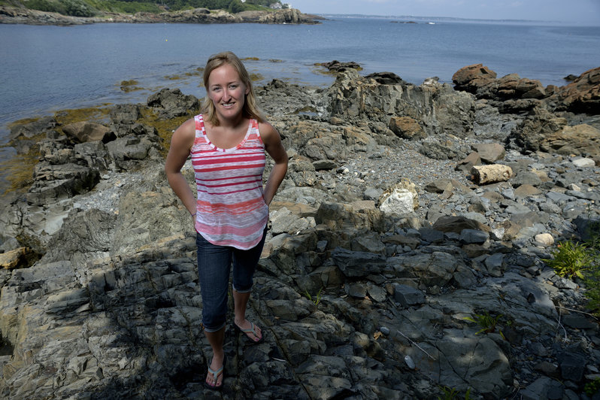Lobsterwoman turned marine biologist fishes for answers

Marissa McMahan’s family has been commercial fishing in the Gulf of Maine for more than three generations. “My grandfather used to go out and harpoon tons of bluefin tuna back in the day,” said McMahan, a second-year doctoral student working in associate professor Jon Grabowski’s laboratory at Northeastern’s Marine Science Center in Nahant, Massachusetts.
Eventually the bluefin disappeared from Maine’s waters, followed by the cod. The family has watched as one fishery after another has collapsed, leaving only the lobster as a viable source of income. But in recent years they’ve started to see a rise in an altogether new species: the black sea bass, which used to only been seen on the south side of Cape Cod.
McMahan began lobstering with her father when she was just 7 years old. Then, as a high school student, she got her own skiff and traps and used her fishing income to help put herself through college. After completing her master’s degree at the University of Maine she returned to the decks and pondered the next step in her career. It was that summer of 2012 when she and her dad started noticing something fishy.
“My dad had seen one or two sea bass in his traps before, but that summer we probably caught 10 and that seemed outrageous,” said McMahan, who didn’t even recognize the fish when she saw it. “That following summer he probably collected 35. It just kind of blew out of control.”
This trend has likely come about thanks to warming northerly waters due to climate change. It’s also the inspiration behind her doctoral dissertation work, which she’s now pursuing with the help of a prestigious Graduate Women in Science fellowship.
The problem is that sea bass eat crustaceans such as lobsters. In the southern climes where they are most prominent, shellfish such as shrimp and crabs make up more than 50 percent of the sea bass diet. When their habitat starts to overlap with that of juvenile lobsters, one has to wonder: will they start eating them, too?
“They’re a very aggressive, very territorial species,” McMahan said. “They just chase everything away from their territory.” They’ve even chased her while she was trying to count and measure them for her research. So it’s not unreasonable to think that the sea bass may chase away the lobsters, too—if they don’t eat them first. Maine lobstermen, she said, think the species is a major potential threat to their livelihoods.
But here’s the strange thing: In the south, sea bass goes for twice as much money as lobsters. The latter are becoming undervalued in the gulf, where they’re actually overabundant thanks to highly successful management practices. But there’s currently no market for Maine sea bass, so the lobsters remain king. “Whether or not it’s seen as invasive and harmful is going to define how management comes into play,” McMahan said. She thinks there will be a tipping point, a moment when the lobstermen won’t just see this as a threat but as a potential new market. “But when will that happen? When will that change occur?”

McMahan and a colleague collect field data about the black sea bass, whose range expansion due to climate change is impacting local fisheries. Photo courtesy of Marissa McMahan.
For her dissertation, McMahan is trying to get at the heart of that question. Not only is she studying the ecological impacts of the sea bass’s range expansion, she’s also interested in the social side of the coin. She is working with fellow lab member Stephen Scyphers to design a series of paper surveys to administer to lobstermen, policymakers, and scientists about their perceptions of the growing sea bass fishery. She’ll also be doing dive surveys in Massachusetts, New Hampshire, and Maine to get a better estimate of the abundance and behavior of the fishery as it moves northward.
Finally, McMahan is partnering with fishermen to collect samples of sea bass that turn up in their nets and traps. She will use the samples to gather information about the sea bass’ age, size, and sex, as well as what they’ve been eating in recent days and over the past several months.
“Basically the idea is to take all of these different measurements and compare them between regions,” McMahan said. She’ll use that information to assess whether sea bass in the newer, more northern part of the range have a different impact on the ecosystem than those in the range where they’ve traditionally been found. As she put it, “So in Maine where there’s a lot of juvenile lobsters, are they eating more lobsters because they’re just so abundant?”
She hopes the scientific data coupled with the survey responses will provide a holistic picture of the future of the northern sea bass fishery. “I’m only studying sea bass right now, but what I’d really like is to test run what I’m doing as an overall model for how to monitor invasive and emergent species,” she said.
Essentially, this work should serve as a blueprint for future conundrums in marine biology as climate change continues to push the literal boundaries of the nation’s fisheries.





